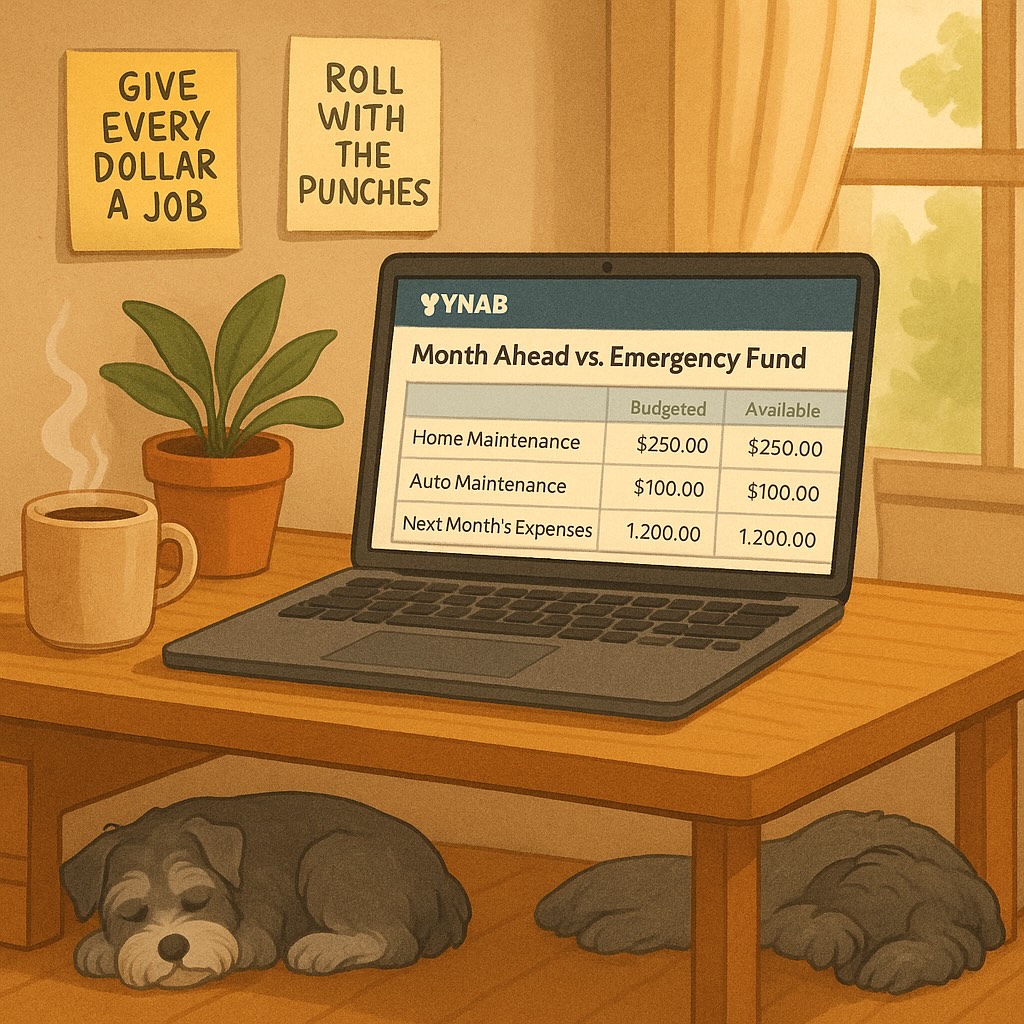Emergency Fund v. Month Ahead

I’ve been browsing the You Need A Budget (YNAB) subreddit lately and have noticed an interesting discussion. What do you do first: get one month ahead or set up an emergency fund? For me, getting a month ahead is the emergency fund. Let me explain…
The YNAB Debate: Emergency Fund vs. Getting a Month Ahead
We’ve all heard the advice - you need to have $1000 in an emergency fund and have 3-6 months of expenses saved. Prior to using YNAB, I had this general savings account that I threw money into each month. I told myself that’s our emergency fund, our 3-6 months of expenses, money for our next vacation, money to purchase the next laptop, plus a million other things. But, money is scarce. I have a limited amount and each dollar can only do one thing. You might say it can only have one job.
Traditional Emergency Fund Advice
When I started YNAB, I took the money from my general savings account and used it to fund some savings categories. I created home and auto maintenance categories. Those two categories were my emergency fund. If an emergency occurs, it’s either going to be with my house or my car. It could be medical, but I have other savings for that.
Implementing YNAB's Rule #1: Give Every Dollar a Job
I also created some additional savings categories for big ticket items - vacations, new technology, etc. Any time we want to save for something, we add a category, set a goal, and start saving.
Getting Two Months Ahead: Our Real Emergency Fund
In addition, I have worked to get us two months ahead in the budget. It’s funny because I’m not sure when it happened, but all of a sudden, I was able to throw more and more of my paychecks at the next month until all of the current month’s paychecks covered the next month’s expenses. When my husband got his bonus this year, I used it to fund us two months out.
Rethinking the 3-6 Month Emergency Fund Rule
And I consider two months, even one month ahead, as our 3-6 months of expenses. If one of us were to lose our job, we wouldn’t quite live the lifestyle we live now. We’d adjust to living on one income. I’d take us down to our bare bones budget - all necessary monthly bills, yearly expenses, groceries, gas, and dog expenses. We’d eliminate some of our more discretionary monthly bills and categories and pull money from some of our sinking funds (tech, vacation, etc.). When I look at the numbers, we have about 7 ½ months of bare bones expenses saved.
Why YNAB Users May Not Need a Traditional Emergency Fund
Personally, having an emergency fund while using YNAB seems to go against Rule 1 - give every dollar a job. For what do you have an emergency fund? What is this vague emergency that will cost $1000 or less? If you follow rules 1 and 2 of YNAB - give every dollar a job and save for your true expenses, you’re planning more strategically for emergency situations. And if something happens and you need more than you’ve saved in one category, you put rule 3 into action - roll with the punches. Move money from another category to cover what you need.
Using YNAB's Four Rules Instead of an Emergency Fund
If you use YNAB, you don’t need an emergency fund. The four rules (or habits) of YNAB will prepare you for any money emergency.
Other Posts
-
A Love Letter to YNAB
Since starting YNAB, the way I handle money has totally changed. I used to just track my spending, but now I actually budget. I know where every dollar is going, I save with intention, and I don’t feel guilty when I spend—because it’s all part of the plan. Honestly, I can’t imagine using anything else.
-
Track Your Spending
Think budgeting is too hard or time-consuming? I break it down into simple steps—starting with just tracking your spending. Learn how to see where your money actually goes, categorize your expenses, and lay the foundation for a realistic, personalized budget.
-
Millennials and Money
Tired of hearing millennials blame their parents for not teaching them about money? We need to call out the excuses and emphasize personal responsibility. With 20 years of financial info at our fingertips, it’s time to stop blaming and start learning. Many of us already have.